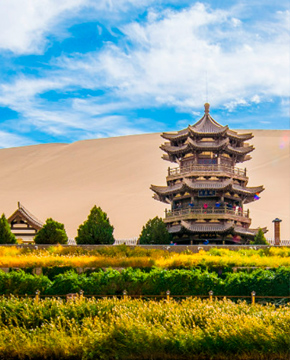arim Basin, 1400kilometers long and 550 kilometers wide, 560000square kilometers in area, lies between Tianshan Mountains, Kunlun Mountains and Altun Mountains and it is the largest basin in China. According to the scientists, the Basin was formed in the land shift during the late Sinian Period, so it has rich ancient geographic and climatic information in it and great amount of reserves of oil, natural gas, coal, uranian, salt, lead and zin. The central area of the Basin is Taklamakhan Desert, the second largest in the world and the largest in China. The Desert is 1000 kilometers from the western edge to the eastern edge and 400kilometers from the northern to the southern. It is very dry with endless sand dunes but with very little vegetation. So it is called the “Sea of the Death”. However, the huge mountain ranges circling the Basin provide it with water for life, and there are many oases with rivers and lakes around the Basin, such as Kashgar Oasis, Yarkent Oasis, Aksu Oasis, which are important in grain and cotton production of Xinjiang. Tarim River, the longest inland river in China, flow within the Basin and when in its prime, the river was 2100 kilometers long, almost flew through the whole Basin. In the ancient times, many “town states” dependent on the natural resources provided by the oasis, rivers and lakes were established in the Tarim Basin, and the southern and middle routes of the ancient Silk Road went along the Basin, thus the regional ancient civilizations were developed. Due to the changes in the nature and human world, many of the “town-states” were buried by the sand. Since the 19th century, Tarim Basin has been a hot area for explores who came here to look for the ancient sites of the civilization and to recover the ancient civilizations.



